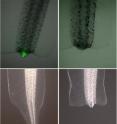Sodium plays key role in tissue regeneration
Sodium gets a bad rap for contributing to hypertension and cardiovascular disease. Now biologists at Tufts University's School of Arts and Sciences have discovered that sodium also plays a key role in initiating a regenerative response after severe injury. The Tufts scientists have found a way to regenerate injured spinal cord and muscle by using small molecule drugs to trigger an influx of sodium ions into injured cells. The approach breaks new ground in the field of biomedicine because it requires no gene therapy; can be administered after an injury has occurred and even after the wound has healed over; and is bioelectric, rather than chemically based.
In a paper appearing as the cover story of the September 29, 2010, issue of the Journal of Neuroscience, the Tufts team reported that a localized increase in sodium ions was necessary for young Xenopus laevis tadpoles to regenerate their tails – complex appendages containing spinal cord, muscle and other tissue.
Like human beings, who regenerate fingertips only as children, these tadpoles lose the ability to regenerate their tail with age. Most remarkably, it was shown that such "refractory" tadpoles whose tails had been removed could be induced to make a perfect new tail by only an hour of treatment with a specific drug cocktail.
The findings have tremendous implications for treating wounds sustained in war as well as accidental injuries. The treatment method used is most directly applicable to spinal cord repair and limb loss, which are highly significant medical problems world-wide. It also demonstrates a proof-of-principle that may be applicable to many complex organs and tissues.
"We have significantly extended the effective treatment window, demonstrating that even after scar-like wound covering begins to form, control of physiological signals can still induce regeneration. Artificially causing an influx of sodium for just one hour can overcome a variety of problems, such as the decline in regenerative ability that comes with age and the effect of regeneration-blocking drugs," said Tufts Professor of Biology Michael Levin, Ph.D., corresponding author on the paper and director of the Center for Regenerative and Developmental Biology at Tufts. Co-authors were Research Associate Ai-Sun Tseng, Postdoctoral Associate Wendy S. Beane, Research Associate Joan M. Lemire, and Alessio Masi, a former post-doctoral associate in Levin's laboratory.
The transport of ions in and out of cells is regulated by electronic security doors, or gates, that let in specific ions under certain circumstances. A role for sodium current in tissue regeneration had been proposed in the past, but this is the first time the molecular-genetic basis of the ion flow has been identified, and a specific drug-based treatment demonstrated. Until now, advances in this model system had involved administering therapies before the injury was sustained.
"This is a novel, biomedically-relevant approach to inducing regeneration of a complex appendage," noted Levin.
The Tufts research established a novel role in regeneration for the sodium channel Nav1.2, a crucial component of nerve and cardiac function. It showed that local, early increase in intracellular sodium is required for initiating regeneration following Xenopus tail amputation, while molecular and pharmacological inhibition of sodium transport causes regenerative failure. The new treatment induced regeneration only of correctly-sized and patterned tail structures and did not generate ectopic or other abnormal growth.
"The ability to restore regeneration using a temporally-controllable pharmacological approach not requiring gene therapy is extremely exciting," said the researchers.
Of critical importance, they said, was the discovery that the tail could be induced to regenerate as late as 18 hours after amputation, revealing that tissues normally fated for regenerative failure still maintain their intrinsic characteristics and can be programmed to reactivate regeneration.
Amphibians such as frogs can restore organs lost during development, including the lens and tail. The frog tail is a good model for human regeneration because it repairs injury in the same way that people do: each tissue makes more of itself. (In contrast, regeneration in some other animals occurs through transdifferentiation (one cell type turns into another cell type) or adult stem cell differentiation. Furthermore, though small, the Xenopus larval tail is complex, with muscle, spinal cord, peripheral nerves and vasculature cells.
Source: Tufts University
Other sources
- New key to tissue regeneration: Drug treatment triggers sodium ions to regrow nerves and musclefrom Science DailyWed, 29 Sep 2010, 14:28:18 UTC
- Sodium Plays Key Role in Tissue Regenerationfrom Newswise - ScinewsWed, 29 Sep 2010, 0:56:13 UTC
- Frog May Teach Humans How to Regrow Limbsfrom Live ScienceTue, 28 Sep 2010, 22:21:17 UTC
- Sodium plays key role in tissue regenerationfrom PhysorgTue, 28 Sep 2010, 21:42:31 UTC
